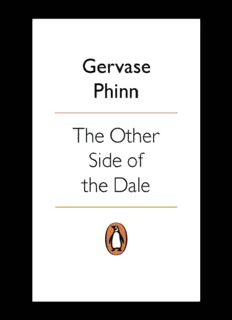
The Other Side of the Dale PDF
Preview The Other Side of the Dale
Gervase Phinn THE OTHER SIDE OF THE DALE Contents Chapter 1 Chapter 2 Chapter 3 Chapter 4 Chapter 5 Chapter 6 Chapter 7 Chapter 8 Chapter 9 Chapter 10 Chapter 11 Chapter 12 Chapter 13 Chapter 14 Chapter 15 Chapter 16 Chapter 17 Chapter 18 Chapter 19 Chapter 20 Chapter 21 Chapter 22 Chapter 23 Chapter 24 Chapter 25 A Child of the Dales Follow Penguin PENGUIN BOOKS THE OTHER SIDE OF THE DALE Gervase Phinn taught in a range of schools for fourteen years until, in 1984, he became General Adviser for Language Development in Rotherham. Four years later he was appointed Senior General Inspector for English and Drama with North Yorkshire County Council and was subsequently made Principal Adviser for the county. He is now a free-lance lecturer and adviser, and Visiting Professor of Education at the University of Teesside. He has published collections of his own plays and stories and has contributed to several anthologies. His own anthology of poems, Classroom Creatures, has been published by Puffin in an expanded edition called It Takes One To Know One. Over Hill and Dale and Head over Heels in the Dales, which continue the story of his career as a School Inspector, are also published by Penguin. Gervase Phinn is widely sought after as a speaker and recently was an immediate star on Esther Rantzen’s television show, Esther, appearing a second time due to public demand. He is married with four children and lives in a village just outside Doncaster. For Christine and all other dedicated teachers who take on the most important duty in society – the education of the young. I am extremely grateful to Cynthia Welbourn, Director of Education, and Edna Sutton, Chief Education Adviser, North Yorkshire County Council, for their support in writing this book. I should like to thank Jenny Dereham, my editor, who has been an exceptionally wise and patient guide, and Esther Rantzen who invited me on to her television show ‘Esther’ and encouraged me to tell my stories in print. A small child was splashing poster paint On a great grey piece of paper. ‘Do you paint a picture every week?’ Asked the school inspector. The small child shook his little head. ‘Hardly ever as a rule, But Miss said we’ve got to paint today – There’s an important visitor in t’school!’ 1 At long last, after a two-hour search up and down the Dale, along muddy twisting roads, across narrow stone bridges, up dirt tracks, past swirling rivers and dribbling streams, and through countless villages in an increasingly desperate search, I had eventually arrived at my destination. At the sight of the highly-polished brass plate on the door bearing the word BACKWATERSTHWAITE , I heaved a great sigh of relief and felt that sort of pioneering triumph SCHOOL which Christopher Columbus, Captain Cook and Scott of the Antarctic must have felt on arriving at their destinations after their difficult journeys. I had seen no school sign, no traffic triangle warning of a school and children crossing, no playground, playing field, nothing that would identify the austere building as an educational institution. The tall, gaunt edifice deep in the dark valley looked like any other large, sturdy Yorkshire country house and I had passed it unknowingly several times during my vain attempt to discover the elusive school. Beneath the slate roof, greasy grey and edged with a pale purple lichen, tall leaded windows faced the ever-watchful fields. From the grey and white limestone walls gillyflowers and tiny ferns creviced. A little beck trickled alongside as I made my way to the heavy oak door. At long last I had arrived. I lifted the great grey iron knocker in the shape of a ram’s head and let it fall with a heavy echoing thud. I had arrived at Upperwatersthwaite much earlier in the afternoon assuming, quite foolishly, that it was somewhere near Backwatersthwaite. As soon as I stepped through the door of the small village post office to ask for directions, all conversation ceased and every eye was directed my way. There were two sturdy,
Description: